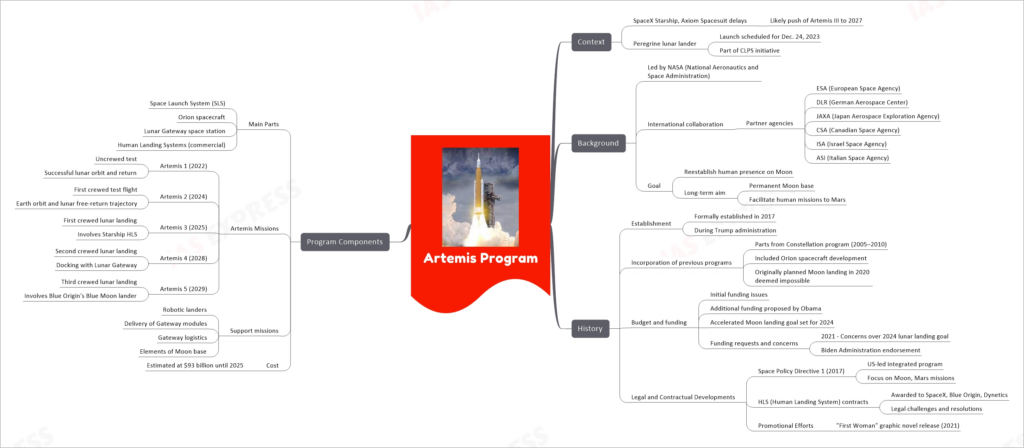Artemis Program
This topic of “Artemis Program” is important from the perspective of the UPSC IAS Examination, which falls under General Studies Portion.
Introduction
In recent developments of December 2023, the Artemis Program faces significant delays due to challenges with SpaceX Starship and Axiom Spacesuit, potentially pushing the Artemis III mission to 2027. This setback comes as NASA prepares for the Peregrine lunar lander’s launch under the Artemis program.
Background of the Artemis Program
The Artemis Program, spearheaded by NASA, is an international effort involving agencies like ESA, DLR, JAXA, CSA, ISA, and ASI. It aims to reestablish human presence on the Moon since the Apollo 17 mission in 1972 and envisions setting up a permanent base on the Moon to facilitate human missions to Mars.
Historical Context
Initiated in 2017 during the Trump administration, the program integrates elements from previous NASA missions, including the Constellation program. Despite initial budget challenges and the impossibility of a planned 2020 Moon landing, additional funding and support were garnered, especially under the Obama and Biden administrations. Notably, Space Policy Directive 1 in 2017 and subsequent funding to SpaceX, Blue Origin, and Dynetics marked significant milestones in the program’s development.
Program Components
The Artemis Program comprises the Space Launch System, Orion spacecraft, Lunar Gateway space station, and commercial Human Landing Systems. It includes several missions: Artemis 1 (an uncrewed test in 2022), Artemis 2 (the first crewed test flight in 2024), Artemis 3 (the first crewed lunar landing, now potentially delayed to 2027), Artemis 4 (second crewed lunar landing in 2028), and Artemis 5 (third crewed lunar landing in 2029). Support missions integral to the program’s success include robotic landers, Gateway module delivery, and Moon base elements. The program’s projected cost is around $93 billion until 2025.
Recent Developments
As of December 2023, the Artemis Program faces a notable challenge with the potential delay of the Artemis III mission to 2027, mainly due to issues with SpaceX Starship and Axiom Spacesuit. Concurrently, the Peregrine lunar lander, part of the CLPS initiative, is scheduled to launch on December 24, 2023, signifying continued progress despite setbacks.
Conclusion
While facing recent challenges and potential delays, the Artemis Program remains a pivotal endeavor in space exploration, aiming to extend human presence beyond Earth and laying the groundwork for future interplanetary missions.


